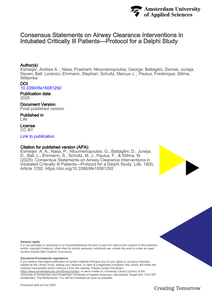Patients who are critically ill and receiving invasivemechanical ventilation are at increased risk for accumula-tion of secretions in the lower airways. Such accumula-tion of airway mucus can induce atelectasis and contributeto ventilator-associated pneumonia. Preventive airwaycare interventions, including humidification, endotrachealsuctioning, and pharmacologic interventions, are thereforefrequently initiated during invasive ventilation. However,evidence for the efficacy of these interventions is scarce,and the absence of guidelines enhances variation in indica-tions for their use. Currently, the choice and timing of interventions aremainly driven by clinical assessment of mucus viscosity based on a mucus classification scale or preference by thetreating physician. Alternatively, airway mucus proper-ties can be measured through rheology, a more objectiveparameter, which characterizes its biophysical properties(eg, viscoelasticity). Previously, studies reported that rhe-ology of airway secretions may help classify chronic muco-obstructive respiratory diseases and serve as a marker ofdisease progression. In this study, we tested the hypoth-esis that airway mucus viscoelastic properties, as measuredby rheology in patients who are critically ill and receivinginvasive mechanical ventilation, correlates with its clinicalmucus classification score.
DOCUMENT
Effective clearance of inhaled particles requires mucus production and continuous mucus transport from the lower airways to the oropharynx. Mucus production takes place mainly in the peripheral airways. Mucus transport is achieved by the action of the ciliated cells that cover the inner surface of the airways (mucociliary transport) and by expiratory airflow. The capacity for mucociliary transport is highest in the peripheral airways, whereas the capacity for airflow transport is highest in the central airways. In patients with airways disease, mucociliary transport may be impaired and airflow transport may become the most important mucus transport mechanism.
MULTIFILE

Intubated critically ill patients are susceptible to secretion accumulation because of compromised airway clearance. Various airway clearance interventions are employed to prevent complications arising from mucus retention. This Delphi study aims to collect global opinions in an international expert panel of ICU professionals on the usefulness of these various airway clearance interventions. A steering committee performed a literature search informing the formulation of statements. Statements are grouped into two distinct parts: (1) Humidification and Nebulization, and (2) Suctioning and Mucus mobilization techniques. For each part, a diverse panel of 30–40 experts will be selected, with concerted effort to involve experts from various medical specialties involved in airway clearance methods. Multiple choice questions (MCQs) or 7-point Likert-scale statements will be used in the iterative Delphi rounds to reach consensus on various airway clearance interventions. Rounds will continue until stability is achieved for all statements. Consensus will be deemed achieved when a choice in MCQs or a Likert-scale statement achieves ≥75% agreement or disagreement. Starting from the second round of the Delphi process, stability will be assessed using non-parametric χ2 tests or Kruskal–Wallis tests. Stability will be defined by a p-value of ≥0.05.
DOCUMENT

Aanleiding: De belangstelling voor gezonde en veilige voeding is groot. Bij de gezondheidseffecten van voeding spelen de darmen een cruciale rol. Verschillende soorten bedrijven hebben behoefte aan natuurgetrouwe testmodellen om de effecten van voeding op de darmen te bestuderen. Ze zijn vooral op zoek naar modellen waarvan de uitkomsten direct vertaalbaar zijn naar het doelorganisme (de mens of bijvoorbeeld het varken) en die niet gebruikmaken van kostbare en maatschappelijke beladen dierproeven. Doelstelling Het project 2-REAL-GUTS heeft als doel om twee innovatieve dierproefvrije darmmodellen geschikt te maken voor onderzoek naar voedingsconcepten en -ingrediënten. De twee darmmodellen die worden toegepast zijn darmorganoïden, minidarmorgaantjes bestaande uit stamcellen, en darmexplants bestaande uit hele stukjes darm verkregen uit relevante organismen. Beide modellen hebben potentieel heel uitgebreide toepassingsmogelijkheden en hebben ook grote voordelen ten opzichte van de huidige veelgebruikte cellijnen, omdat ze meerdere in de darm aanwezige celtypen bevatten en uit verschillende specifieke darmregio's te verkrijgen zijn. Gezamenlijk gaan de partners werken aan: 1) het aanpassen van de kweekomstandigheden zodat darmmodellen geschikt worden om de vragen van partners te beantwoorden; 2) het vaststellen van de toepassingsmogelijkheden van de darmmodellen door verschillende stoffen en producten te testen. Beoogde resultaten Kennisconferenties, publicaties en exploitatie van de modellen zullen zorgen voor het verspreiden van de opgedane kennis. Omdat het project gebruikmaakt van moderne, op de toekomst gerichte laboratoriumtechnieken (kweekmethoden met stamcellen en vitaal weefsel, moleculaire analyses en microscopie), leent het zich uitstekend om geïmplementeerd te worden in het hbo-onderwijs. Als spin-off zal het project dan ook voorzien in een specifieke, voor Nederland unieke hbo-minor op het gebied van stamcel- en aanverwante technologie (zoals organ-on-a-chiptechnologie).